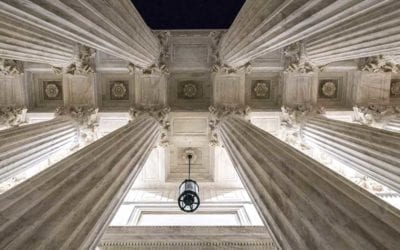Involuntary Bankruptcy Petition
Bankruptcy Code section 303 provides that when a creditor holding an undisputed claim believes a business or individual will not pay its debts, the creditor may initiate an involuntary bankruptcy proceeding by filing a petition with the Bankruptcy Court as either a Chapter 7 liquidation or a Chapter 11 reorganization. Involuntary bankruptcies are usually filed where the creditors suspect that a debtor is deliberately choosing not to pay its debts, usually while dissipating assets and/or preferring other creditors. Involuntary bankruptcy filings are complex proceedings that require knowledgeable and expert counsel to ensure a successful outcome. Thomas H. Curran Associates has the expertise and experience required to bring an involuntary bankruptcy filing on behalf of petitioning creditors.
Involuntary bankruptcy requirements. If a debtor has 12 or more creditors, the petition must be filed by at least three creditors, each holding a claim “that is not contingent as to liability or the subject of a bona fide dispute as to liability or amount.” If the debtor has less than 12 qualifying non-insider creditors, a single creditor may file the involuntary bankruptcy petition. If filed by fewer than three creditors, the petitioners must have claims against the debtor that amount to at least $16,750 in the aggregate based on current indexing.
Involuntary Bankruptcy Process. When an involuntary bankruptcy petition is filed, the debtor is not placed into bankruptcy immediately. Rather, under 303(f) a debtor may continue its operations as if a bankruptcy case had not been filed. The involuntary petition is treated in a manner that is similar to a civil lawsuit against the debtor: the involuntary bankruptcy petition must be served on the debtor in conjunction with a summons. After receiving an involuntary bankruptcy petition, the debtor has the option of consenting to bankruptcy filing or fighting the petition. If a business receives an involuntary Chapter 7 petition, the company also has the option of responding by filing for Chapter 11 bankruptcy and taking control over the bankruptcy estate as a debtor-in-possession. Once filed, the involuntary petition cannot be dismissed without notice and an opportunity for a hearing, even if the creditors agree to dismiss the action. The creditors of a debtor will be subject to the automatic stay to prevent other creditor actions. However, the Bankruptcy Court has the authority to appoint an interim trustee in an involuntary case, or place restrictions on the debtor’s activities, but the petitioning creditor must seek them by filing a motion with the court. There are many other provisions applicable to an involuntary bankruptcy filing, which require experienced bankruptcy counsel to successfully navigate.
Filing an involuntary bankruptcy petition against an individual or a business is a complex process in which the petitioning creditor could be found liable for the debtor’s attorneys’ fees and damages if it is unsuccessful. Likewise, a company that is subject to an involuntary petition may face the prospect of being forced into bankruptcy proceedings when they are not warranted. Our experienced bankruptcy attorneys at Thomas H. Curran Associates have the skills necessary to ensure clients successfully navigate involuntary bankruptcy proceedings to achieve the best possible outcome.
Bankruptcy Practice Results
Recent successful cases handled by the attorneys from Thomas H. Curran Associates. Find more here »
Thomas H. Curran Associates Secures Appellate Victory as Massachusetts Supreme Judicial Court Denies Appellant’s Attempt to Shortcut Ordinary Appellate Review
Thomas H. Curran Associates recently obtained an appellate victory in the Massachusetts Supreme Judicial Court on May 26, 2023, in the...
Thomas H. Curran Associates win is Affirmed in Florida, U.S. District Court – Client Wins Attorneys Fees
Law: Federal Rule of Civil Procedure 37(a)(5) Case: Premier Capital, LLC v. Larry Bryan (AP) Underlying Bankruptcy Case: In re Larry Bryan...
The Second Circuit Affirms Bankruptcy Fraud Judgment Obtained by Thomas H. Curran Associates, Recognizing the Continuous Concealment Doctrine
Law: Continuous concealment doctrine, 11 USC § 727(a)(2)(A), In re Olivier, 819 F.2d 550 (5th Cir. 1987); In re Boyer, 328 F. App’x 711,...
Thomas H. Curran Associates prevails on barring discharge due to fraud by debtor
Thomas H. Curran Associates recently secured a victory on behalf of an institutional asset manager, where the Bankruptcy Court for the...
Thomas H. Curran Associates prevails on post-trial motions and obtains full security for $23 million dollar financial fraud judgment on behalf of chapter 7 bankruptcy trustee
On February 8, 2022, the United States District Court for the District of Connecticut (Meyer, J.) enter its Order denying defendant Gayle...
Thomas H. Curran Associates obtains appellate victory for client affirming multi-million dollar Massachusetts Superior Court Contempt Judgment against non-party to Injunction Orders
On June 21, 2021, the Massachusetts Appeals Court affirmed the civil contempt Judgment of the Suffolk Superior Court (Giles, J.) awarding...
Thomas H. Curran Associates Secures Appellate Victory as Massachusetts Supreme Judicial Court Denies Appellant’s Attempt to Shortcut Ordinary Appellate Review
Thomas H. Curran Associates recently obtained an appellate victory in the Massachusetts Supreme Judicial Court on May 26, 2023, in the...
Thomas H. Curran Associates win is Affirmed in Florida, U.S. District Court – Client Wins Attorneys Fees
Law: Federal Rule of Civil Procedure 37(a)(5) Case: Premier Capital, LLC v. Larry Bryan (AP) Underlying Bankruptcy Case: In re Larry Bryan...
The Second Circuit Affirms Bankruptcy Fraud Judgment Obtained by Thomas H. Curran Associates, Recognizing the Continuous Concealment Doctrine
Law: Continuous concealment doctrine, 11 USC § 727(a)(2)(A), In re Olivier, 819 F.2d 550 (5th Cir. 1987); In re Boyer, 328 F. App’x 711,...
Thomas H. Curran Associates prevails on barring discharge due to fraud by debtor
Thomas H. Curran Associates recently secured a victory on behalf of an institutional asset manager, where the Bankruptcy Court for the...
Thomas H. Curran Associates Secures Appellate Victory as Massachusetts Supreme Judicial Court Denies Appellant’s Attempt to Shortcut Ordinary Appellate Review
Thomas H. Curran Associates recently obtained an appellate victory in the Massachusetts Supreme Judicial Court on May 26, 2023, in the...
Thomas H. Curran Associates win is Affirmed in Florida, U.S. District Court – Client Wins Attorneys Fees
Law: Federal Rule of Civil Procedure 37(a)(5) Case: Premier Capital, LLC v. Larry Bryan (AP) Underlying Bankruptcy Case: In re Larry Bryan...
The Second Circuit Affirms Bankruptcy Fraud Judgment Obtained by Thomas H. Curran Associates, Recognizing the Continuous Concealment Doctrine
Law: Continuous concealment doctrine, 11 USC § 727(a)(2)(A), In re Olivier, 819 F.2d 550 (5th Cir. 1987); In re Boyer, 328 F. App’x 711,...
Bankruptcy Areas of Expertise
- Bankruptcy Litigation
- Bankruptcy Trustee Representation
- Avoidance & Recovery Actions
- Chapter 11 Trustees & Examiners
- Discharge Litigation
- Bankruptcy Fraud Investigations
- Cross Border Foreign Litigation
- 363 Bankruptcy Sales
- Bankruptcy Preference Actions
- Involuntary Bankruptcy
- Chapter 11/13 Plan Objections
Bankruptcy News
Evidence of Intent to ‘Hinder’ Wasn’t Sufficient to Deny Discharge, District Judge Says
In the recent case Wylie v. Miller, 22-10952 (S.D. Mich. March 29, 2024) [1] , a bankruptcy court’s decision to deny a couple’s discharge...
Creditor’s Don’t Receive Estate Assets Recovered After the Last Chapter 13 Plan Payment
In In re McCrorey, 18-00696 (Bankr. D. Idaho Jan. 26, 2024) [1] , Chief Bankruptcy Judge Noah G. Hillen of Boise, Idaho, held that if a...
Electric Scooter Company Bird files for Bankruptcy | CNBC
Bird, the popular electric scooter rental company filed for Chapter 11 bankruptcy protection in Florida Federal Court last month. Bird's...
Nearly 20-year-old Dallas restaurant chain files for Ch. 7 bankruptcy | WFAA-TV
The Dallas-based company Buzzbrews Inc. filed for Chapter 7 bankruptcy protection lasat month in the U.S. Bankruptcy Court for the...
A Refinanced Consumer Loan Might Not Be a ‘Consumer Debt,’ Ninth Circuit Says
In Centennial Bank v. Kane (In re Kane), 22-16282 (9th Cir. Nov. 15, 2023), the debtor had refinanced four preexisting loans. [1] The...
Bankruptcy Code Overrides Contrary Delaware Corporate Law, Judge Lopez Says
In In re Envision Healthcare Corp., 23-90342 (Bankr. S.D. Tx. Sec. 12, 2023), Bankruptcy Judge Christopher M. Lopez held that Delaware law...
Evidence of Intent to ‘Hinder’ Wasn’t Sufficient to Deny Discharge, District Judge Says
In the recent case Wylie v. Miller, 22-10952 (S.D. Mich. March 29, 2024) [1] , a bankruptcy court’s decision to deny a couple’s discharge...
Creditor’s Don’t Receive Estate Assets Recovered After the Last Chapter 13 Plan Payment
In In re McCrorey, 18-00696 (Bankr. D. Idaho Jan. 26, 2024) [1] , Chief Bankruptcy Judge Noah G. Hillen of Boise, Idaho, held that if a...
Electric Scooter Company Bird files for Bankruptcy | CNBC
Bird, the popular electric scooter rental company filed for Chapter 11 bankruptcy protection in Florida Federal Court last month. Bird's...
Nearly 20-year-old Dallas restaurant chain files for Ch. 7 bankruptcy | WFAA-TV
The Dallas-based company Buzzbrews Inc. filed for Chapter 7 bankruptcy protection lasat month in the U.S. Bankruptcy Court for the...
Evidence of Intent to ‘Hinder’ Wasn’t Sufficient to Deny Discharge, District Judge Says
In the recent case Wylie v. Miller, 22-10952 (S.D. Mich. March 29, 2024) [1] , a bankruptcy court’s decision to deny a couple’s discharge...
Creditor’s Don’t Receive Estate Assets Recovered After the Last Chapter 13 Plan Payment
In In re McCrorey, 18-00696 (Bankr. D. Idaho Jan. 26, 2024) [1] , Chief Bankruptcy Judge Noah G. Hillen of Boise, Idaho, held that if a...
Electric Scooter Company Bird files for Bankruptcy | CNBC
Bird, the popular electric scooter rental company filed for Chapter 11 bankruptcy protection in Florida Federal Court last month. Bird's...
Contact Us
Are You In Need of Legal Counsel for a Bankruptcy Matter, Business Transaction, or Commercial Litigation?
Contact our team today.
Call us at (617) 207-8670 or use the quick contact form below.
Austin Office
111 Congress Avenue
Suite 500
Austin, TX 78701
Boston Office
Ten Post Office Square
Suite 800 South
Boston, MA 02109
New York Office
1740 Broadway
15th Floor
New York, NY 10019
London Office
The Leadenhall Building
Level 30
122 Leadenhall Street
London EC3V 4AB
Tags: involuntary bankruptcy petition involuntary bankruptcy filing involuntary bankruptcy requirements





